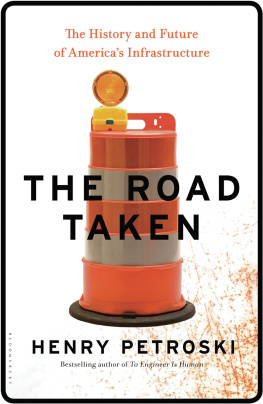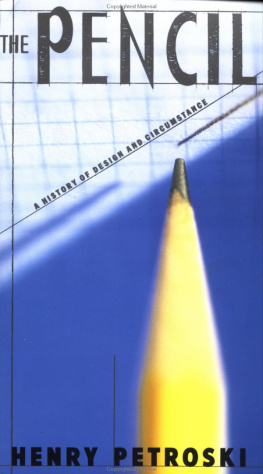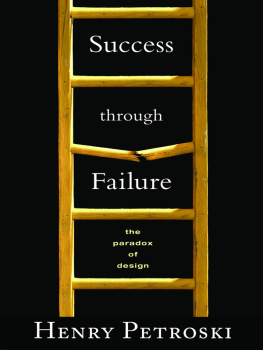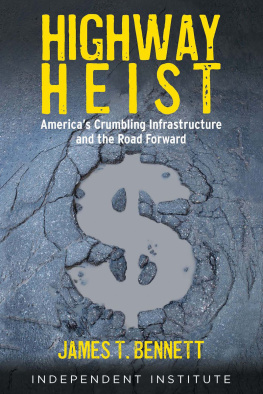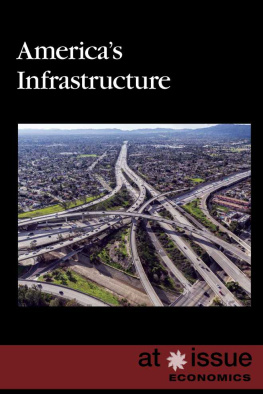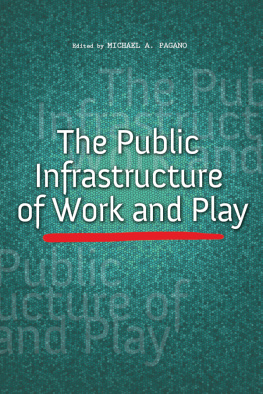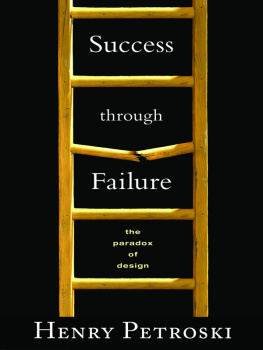To William Henry
By the Same Author
The House with Sixteen Handmade Doors: A Tale of Architectural Choice and Craftsmanship
To Forgive Design: Understanding Failure
An Engineers Alphabet: Gleanings from the Softer Side of a Profession
The Essential Engineer: Why Science Alone Will Not Solve Our Global Problems
The Toothpick: Technology and Culture
Success Through Failure: The Paradox of Design
Pushing the Limits: New Adventures in Engineering
Small Things Considered: Why There Is No Perfect Design
Paperboy: Confessions of a Future Engineer
The Book on the Bookshelf
Remaking the World: Adventures in Engineering
Invention by Design: How Engineers Get from Thought to Thing
Engineers of Dreams: Great Bridge Builders and the Spanning of America
Design Paradigms: Case Histories of Error and Judgment in Engineering
The Evolution of Useful Things
The Pencil: A History of Design and Circumstance
Beyond Engineering: Essays and Other Attempts to Figure Without Equations
To Engineer Is Human: The Role of Failure in Successful Design

Contents
givens, choices, forks, sighs
words, reports, and grades
dirt, stone, wood, concrete, asphalt
transcontinental journeys and interstate dreams
centerlines, stop signs, traffic lights
earthquakes, envy, and embarrassments
elevateds, subways, and engineers
location, location, locationand financing
iconic, signature, and stunning spans
guardrails, medians, and Jersey barriers
streets, lawns, speed bumps, potholes
sidewalks, curbs, gutters, horses, pavements
quality, shoddiness, and survivor bias
good enough bridges and bad enough tools
triage, budgets, and choices, again
corruption, graft, waste, fraud, abuse
fuel taxes, trust funds, and politics
economics, wrong turns, and political choices
pedestrians, preservationists, parks
public-private partnerships: pluses and minuses
smart cars and pothole-free roads
Today there is a heightened awareness of the importance of our physical infrastructure to the economic health of the nation and the well-being of its citizens, not to mention to our national pride. Bridge and building collapses, water main breaks, sinkholes, deteriorating roads, and more have propelled infrastructure to hot-topic status. Heated debate in Washington about how to finance the maintenance, restoration, and replacement of our aging infrastructure has also kept the subject in the news. However, tight economic times, partisan politics, and public skepticism about whether our public works are being honestly and properly built and cared for have made it difficult to find the resources to do what truly needs to be done. The infrastructure problem is sure to grow in importance and interest, but unless our nations attitude towards it changes, it is not likely to be solved anytime soon.
This book is about our infrastructureits nature, its history; its pluses, its minuses; its funding and its financing; and its future. The nature and history of anything should be part of objective reality, but what a particular author chooses to include or exclude in describing and telling a tale can obviously bias the story. I have tried to present the infrastructure and issues relating to it in an evenhanded way, but it will naturally be from one travelers point of view, which means that my education and experience as an engineer and lifelong student of the quotidian will have a lot to do with what I know and see, what I hear and read, how I evaluate and interpret it, and what I emphasize and what I pass over.
In conventional treatments of our highway infrastructure, roads and bridges receive the bulk of the attention. This book contains its share of roads and bridges, but additionally, it considers in some detail the parts of roads that are often overlooked: their seams and their edges, their potholes and their fringes. The centerlines, curbs, and gutters are considered, as are guardrails and medians, road signs, and traffic signals. These finishing details of the hardware are complemented by the software represented by the conventions of driving and the rules of the road, which are also treated in this book. These intangible adjuncts to highway infrastructure are every bit as important as are the tangible grade, bank, and curve of the pavement in making it safe and efficient to ride upon. And how well the details are attended toin their design, construction, and maintenancecan tell us a lot about how well the underlying road itself is made and maintained. As with everything else designed, the success or failure of a piece of infrastructure is ingrained in the details.
Whether we like it or not, infrastructure is steeped in politics and we vote on issues relating to it accordingly. We vote for roads and against potholes; for fixing our bridges and against the taxes to do so; for pork and earmarks but not necessarily for the common good. We vote by anecdote, by what we want and need and see and feel daily in our own neighborhoods, towns, cities, and regions. It is often said that all politics is local; when it comes to roads and bridges, it is also state and federal, for those governments are the principal sources of regulations and funds to plan, design, build, and maintain capital investments. It is where roads lead and what bridges spanand whether they are perceived to do so well or poorlythat feed the anecdotal gossip and influence the vote. At present, in one way or another, all roads seem to lead to and from Washington, although since the federal government has been finding it increasingly difficult to match revenue for and spending on infrastructure, it has been signaling that it leans toward throwing the problem into the hands of the states. Whether or not the states are prepared to shoulder the full responsibility for their infrastructure remains to be seen.
In this book, I have chosen chapter titles that allude to Robert Frosts The Road Not Taken. This poem, which opened Frosts 1916 collection, Mountain Interval, was written at a time when the automobile was young and roads were far from what we know them capable of being today. However, like all brilliant literature, the poem is essentially about timeless thoughts and themes. The infrastructural dilemmas faced by citizens and their legislative representatives today are fundamentally little different from the choice that a fork in the road presented to Frosts traveler through the woods a century ago. It behooves us all to keep such humble individual experiences in mind as our nation contemplates seemingly impossibly complex choices.
Our nation and its states are at a fork in the road today, and which path they choose to take in dealing with our decaying infrastructure will indeed make all the difference in whether our roads, highways, and bridgesand the economy that so relies upon themcan truly be revitalized. At the time of this writing, we are at a tipping point, in that serious decisions are being made that will influence how we think about infrastructure and our funding of it. By presenting historical background on how our roads, bridges, and traffic habits have come to be as they are, this book describes how past choicesboth good and badhave put us in the position we now are with infrastructure, and also presents the background to and current status of fundamental issues involved in contemporary legislation and practice related to infrastructure. It is imperative that we take into account the successes and, especially, the failures of the past in choosing the path to the future. When our children and grandchildren look back years hence, they will know that our choices made all the difference for us and for them.
Next page
